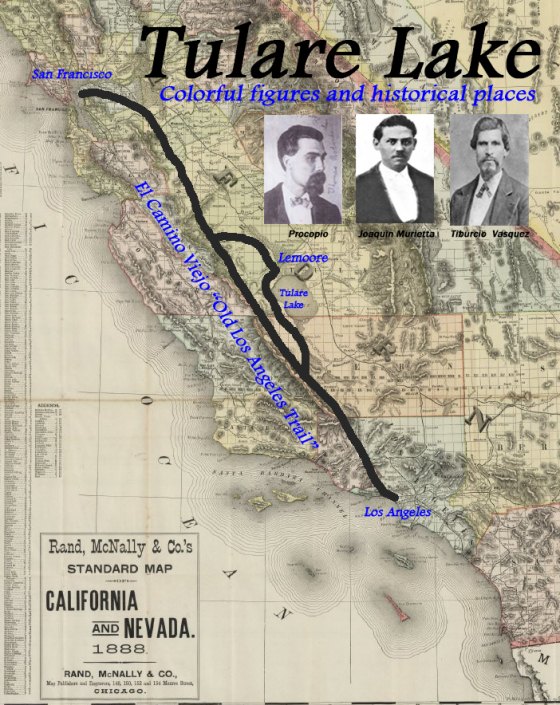The surprises and legends of Old Tulare Lake; an important aspect of state's colorful history

Even Tulare Lake had its own landmarks, almost all of which have disappeared as agriculture and man’s desire to transform the flow of water, have rendered most of them forgotten, only relics of our ancestors’ memories.
Many early Tulare Lake landmarks disappeared as the Lake began to shrink just over 100 years ago. In the next few articles, I hope to identify many of the early Lake areas, which were important enough for early settlers to name, or because historical episodes generated enormous interest.
Atwell Island, Skull Island, El Camino Viejo, and the old Cox and Clark Trading Post are just a few of the long forgotten oddities in and around our Phantom Lake. Murder, thievery, ingenuity, initiative, and sacrifice are all interwoven in bizarre and intriguing stories and legends.
Valley historians have recorded many of these forgotten episodes in historical documents, publications, and recollections of early Valley life. Historian Frank Latta has done a masterful job of capturing early life on the Lake through interviews with those who actually lived, worked and hunted on the “Largest lake west of the Great Lakes.”
Today, on a visit to Tulare Lake, one would see mostly farmland set apart by open spaces of unused land. It is hard to imagine that 150 years ago the area was teaming with wild life and was a fisherman's dream. Reed rafts, barges, sail boats like the “Water Witch,” and the old “Mose Andross” maneuvered the shallow Tulare Lake waters.
Their cargo ranged from hogs and cattle, to sightseers, fishermen, turtle hunters, oil well pipe, and items traded at the various Lake landings. One of the most significant features along the western lakeshore was the “oldest road in the San Joaquin Valley.”
El Camino Viejo
El Camino Viejo, also known as the “Old Los Angeles Trail," was the oldest north-south trail in the interior of California during both Spanish and Mexican periods of colonization from 1769-1848. In other words, it was the Interstate 5 of the day. “The Old Trail” ran from San Pedro Bay north out of the Los Angles basin, over the Tejon Pass, and along the eastern slopes of the costal range.
At Alamo Solo Springs (close to Devil’s Den) the trail split, sending an eastern bypass along the western edge of Tulare Lake, passing west of Lemoore, through the Laguna de Tachie Land Grant, west of Summit Lake, then north to the San Joaquin River (west Fresno) and then turning west to reconnect with the western Trail at Arroyo de Panoche Grande (about the Apricot Tree Restaurant west of I-5).
The western Trail followed close to what is now Highway 33 and I-5, past present day Avenal and east of Coalinga. After the two routes rejoined, the Trail crossed out of the valley at Altamont Pass and into the Livermore Valley before ending at the Oakland Estuary.
Well established by 1820 it was used by Native Americans, early trappers and prospectors. By 1840, trains of “carretas” (small cart-like wagons) and pack animals moved in to the San Joaquin Valley carrying supplies in and out with raw materials. Also, in the 1800s, vaqueros and stockmen used it to drive herds of cattle and horses in and out of the Valley. Banditos, cattle, and horse thieves would also take advantage of the isolation along the “Old Trail.”
Historians have indicated that it was the most favored route for anyone wishing to avoid the prying eyes of Spanish or Mexican government officials, which concentrated their efforts along the more famous "El Camino Real.” Famous banditos, like Joaquin Murietta, Tiburcio Vasquez, and Procopio utilized routes and landmarks along the El Camino Viejo to avoid the law and move freely about California.
Joaquin Murrieta
In the “History of Kings County” by Brown and Richmond (1940) they indicate that Murietta’s most prized hiding place was Cantua Creek (along the Old Trail) and that he trapped wild horses and maintained corrals along the western shores of Tulare Lake. They also point out that there were so many tales about his exploits “it was hard to tell fact from fiction.” During their crime spree, Murietta and his gang are believed to have “killed up to 28 Chinese and 13 Anglos.” On July 25, 1853 a group of Rangers encountered Joaquin and his gang in the vicinity of present day State Routes 33 and 198, then the western route of El Camino Viejo. A gun battle ensued in which Joaquin Murietta was killed along with members of his gang.
The Rangers then organized a series of public exhibits, where spectators could pay $1 to see his head and the relics captured at the time of his death. As legend has it, numerous stories soon emerged of Murietta sightings and reports of him living to an old age. Any modern day investigation ended when his preserved head was destroyed in the San Francisco earthquake and fire in 1906.
Procopio, also kown as Red-Handed Dick, Tomoso Bustemata, and other alias
Procopio, also known as “Red-Handed Dick" and with other aliases, was twice convicted of cattle theft and remanded to San Quentin both times. Some say his nickname “Red-Handed Dick” was because of his red hair and others say it was because of his bloodthirsty nature.
He was never convicted of the murders he was alleged to have committed. His mother was a sister to Joaquin Murrietta, who also shared fame in and around Tulare Lake. In 1863 he was arrested for cattle thievery and sent to San Quentin for 7 years. After his release in March of 1871, he was immediately suspected of stealing cows around Livermore, and to avoid arrest, moved south to Monterey County. There Procopio teamed up with notorious Tiburcio Vasquez. In late 1871 they robbed a Visalia stagecoach near Soap Lake and committed other robberies.
In 1872, with the law hot on his trail Procopio was again captured in San Francisco. He managed to avoid a murder charge, but he was sentenced to 7 years for cattle rustling and sent to San Quentin Prison. Paroled in June of 1877 he immediately returned to thievery, leading his gang in raids in Fresno and Tulare Counties. Fleeing south his gang was surrounded and captured on the El Camino Viejo at Tejon Pass, but Procopio managed to escape.
He returned to Tulare County in 1878 to rob the Brownstone and Swartz store in Grangeville. He was reported as saying with gun in hand “You do not know me – no? I am Procopio – the Red Handed Dick. You will open the safe for me, amigo.” Tying up the two clerks, who were left overnight on the floor, he headed for Arroyo Poso de Chane on the El Camino Viejo. His horse drowned as he was crossing a slough near Summit Lake and he was left on foot. He was spotted by the pursuing posse, that included Joel Whiteside of Lemoore and Sol Gladden, a harness maker from Grangeville, but he was lost in the dreaded Valley fog. According to a first-hand account of posse member Joel Whiteside they “found him asleep in the cabin and took him into custody. Procopio asked to dress himself and when he put on his coat, drew two pistols from his breast pocket and opened fire. In the ensuing firefight, posse member Sol Gladden, who was to be married the following week, was shot twice and killed as he entered the cabin.” Procopio made good his escape after the posse had emptied their weapons. The rest of his life is a mystery. Some say he escaped to Mexico or was shot by police in a Mexican cantina, and some maintain he died as late as 1890 in Sonora, Mexico.
Tiburcio Vasquez – A Native Son?
Tiburcio Vasquez was born in Monterey, Alta California, Mexico on August 11, 1835. At age 12, Mexico gave up its rights to Alta California and in another 2 short years named the 31st State of the United States of America. All 3 bandits, Murrieta, Procopio, and Vasquez, had a common purpose to return California to Mexican control and mixed it with their dislike of gringos.
By 1856, at the age of 23, Vasquez was actively rustling horses in the Newhall area, was captured, and spent 5 years in San Quentin. Upon his release, he committed numerous burglaries, cattle thefts, and highway robberies in Sonoma County. Captured after a store robbery in Petaluma he was sent back to prison for 3 years.
At age 31, his bandito reputation preceded him as well as his known mode of operation: “binding the victims behind their back and leaving them face down in the dirt." In 1870, he partnered with Procopio in Monterey County. In one of his Santa Cruz raids he was badly wounded, but managed to escape. In 1873 he gained statewide notoriety for a daring $2,200 robbery and murder at Snyder’s Store in Tres Pinos (about where State Route 198 meets Highway 101). After the governor offered a $1,000 reward for his capture, he and his gang traveled down El Camino Viejo and over Tejon Pass to hide with friends in Antelope Valley. They headquartered along the Old Trail at Elizabeth Lake and Soledad Canyon as the gang continued to rob and steal at every opportunity.
Returning to the San Joaquin Valley, he and his gang robbed the Jones Store at Millerton on November 10, 1873.Then on December 26, 1873, he and his gang raided the entire town of Kingston, making off with $2,500 in cash and jewelry. In Brown and Richmond’s “History of Kings County” (1940) the facts of the robbery are covered in detail. They were able to quote Mr. and Mrs. Phillips and others who were witnesses to the affair. As the plundering continued from store to store “The citizens meanwhile, had heard that the bandits were in town and had formed a posse intending to head off the bandits when they re-crossed the bridge. But one man, in his excitement, fired before the posse got to the place, thus warning the bandits, who escaped.”
Continuing their crime spree in Bakersfield, they robbed a stagecoach from a silver-mining Company near Owens Lake. Then, following the Old Trail, they returned to the Elizabeth Lake area. Thinking they were safe from the law, they continued their crime spree by robbing stagecoaches and lone travelers. In April of 1874, he and his band held a well-known sheepherder for ransom. A posse summoned from Los Angles almost trapped them in the San Gabriel Mountains. Another Escape to add to his good fortune.
Vasquez then took up residence in an adobe home owned by “Greek George” on Rancho La Brea, just south of present day Sunset in West Hollywood. Tiburcio was handsome, charming, and well liked in the Mexican-American community. It is said that women were attracted to him and he had many love affairs, some with married women.
Speculation was that Vasquez had seduced and impregnated Greek George’s niece, and the family, not happy with the affair, informed the Los Angeles Sheriff about Vasquez’s whereabouts. This time there would be no escape for the daring bandit. Tiburico Vasquez was captured on May 14, 1874 and placed in the Los Angeles jail. He was moved to San Francisco by steam ship and eventually stood trail in San Jose. He was found guilty of the Tres Pinos murders and robbery and was hanged in San Jose on March 19, 1875, at the age of 39.
Most of the wagon ruts and trail markers of El Camino Viejo have disappeared from the landscape, but for over 100 years, this Old Trail played an important part in shaping the history of Kings County and Tulare Lake.
Seeking History
- Local congressman, with Republican help, gets language in Senate veterans' bill
- Local congressman, TJ Cox, releases 2020 mid-year report of district accomplishments
- Local Rep. TJ Cox joins California delegation in urging USDA to help feed seniors
- Rep. TJ Cox introduces bipartisan bill to confront threat of methamphetamines
- Congressman Cox secures federal funding for under served communities in Central Valley
- Local officials sign letter urging next COVID-19 aid package includes funding for local government
_0.jpg)

.jpg)



